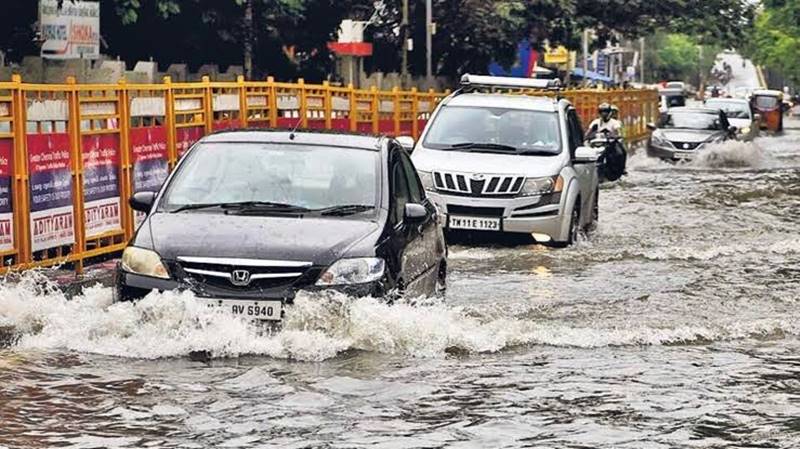Chennai civic body suggests stocking up groceries as IMD forecasts heavy rains in Tamil Nadu today
Apart from suggesting the citizens to stock up the groceries and other essential goods in the wake of the upcoming heavy rainfall, the Chennai civic body has also appealed the people not to approach sensitive locations like lakes or water bodies to take selfies. Details here.


Greater Chennai Corporation Commissioner Gangadeep Singh Bedi informed the press that the efforts are underway to ensure that there is no water stagnation in low-lying areas due to the heavy rainfall.
In the wake of India Meteorological Department (IMD) forecasting heavy rainfall for southern India in the next four days, the Greater Chennai Corporation has advised the citizens to stock up the supplies of essential commodities.
IMD informed that apart from Tamil Nadu, parts of Andhra Pradesh, Karnataka, and Kerala are also likely to witness heavy rainfall from tomorrow onwards. Also, a red alert has been issued by the IMD for Chennai, Kancheepuram, Tiruvallur, and Ranipet districts in Tamil Nadu.
“A Low Pressure Area lies over Southeast & adjoining Southwest Bay of Bengal with the associated cyclonic circulation extending upto 5.8 km above mean sea level. It is likely to move nearly westwards and reach Westcentral & adjoining Southwest Bay of Bengal off south Andhra Pradesh- north Tamilnadu coasts by tomorrow, the 18th November 2021,” the IMD weather bulletin stated today at 07:45 pm.
Explained: What’s leading to heavy rains in Tamil Nadu?
“Light to moderate rainfall at most places with heavy rainfall at isolated places very likely over Rayalaseema, Tamilnadu and Coastal Andhra Pradesh during next 4 days; over Kerala & Mahe during next 3 days and over coastal Karnataka during next 2 days,” it added.
Preparations underway to minimise waterlogging in Chennai
Greater Chennai Corporation Commissioner Gangadeep Singh Bedi informed the press that the efforts are underway to ensure that there is no water stagnation in low-lying areas due to the heavy rainfall.
It is reported that as many as 684 motor pumps have been installed in the low lying areas. The Commissioner added that with the help of the fisheries department, boats have been kept on stand by in sensitive areas as a precautionary measure.
Apart from suggesting the citizens to stock up the groceries and other essential goods in the wake of the upcoming heavy rainfall, the Chennai civic body has also appealed the people not to approach sensitive locations like lakes or water bodies to take selfies.
What’s causing heavy rains in Tamil Nadu?
As per IMD, the genesis of a low-pressure area in the Bay of Bengal near the Tamil Nadu coast is causing turbulent movement of moisture-laden winds towards the state, resulting in heavy rainfall.
According to a briefing prepared by the Climate Trends — a Delhi-based strategic communications company, three weather phenomena have come together and are resulting in massive precipitation in the region. These three phenomena are La Nina, Indian Ocean Dipole (IOD), and Madden-Julian Oscillation (MJO).
The Madden-Julian Oscillation (MJO) is a weather phenomenon which causes a major fluctuation in tropical weather on weekly to monthly timescales. The MJO can be characterised as an eastward movement of cloud and rainfall near the equator that typically recurs every 30 to 60 days.
Also, La Nina is expected to continue with an 85 per cent chance in December 2021- February 2022.
La Nina is observed when the water temperature in the eastern part of the Pacific gets comparatively colder than normal due to which there is a strong high pressure over the eastern equatorial Pacific. The difference in pressure between Eastern Pacific and Western Pacific/Asia causes a moisture-laden wind movement from East to West Pacific and Asia.
According to the meteorologists, La Nina is invariably linked with good northeast monsoon rains during the latter half of the monsoon.
The briefing by the Climate Trends mentions that the IOD event is still persisting and the presence of IOD is favourable for good rains over the Indian mainland.
The IOD is actually an irregular oscillation of sea surface temperatures in which the western Indian Ocean region becomes comparatively warmer and then colder than the eastern part of the ocean. The temperature difference causes movement of moisture-laden winds which pass through peninsular India.

